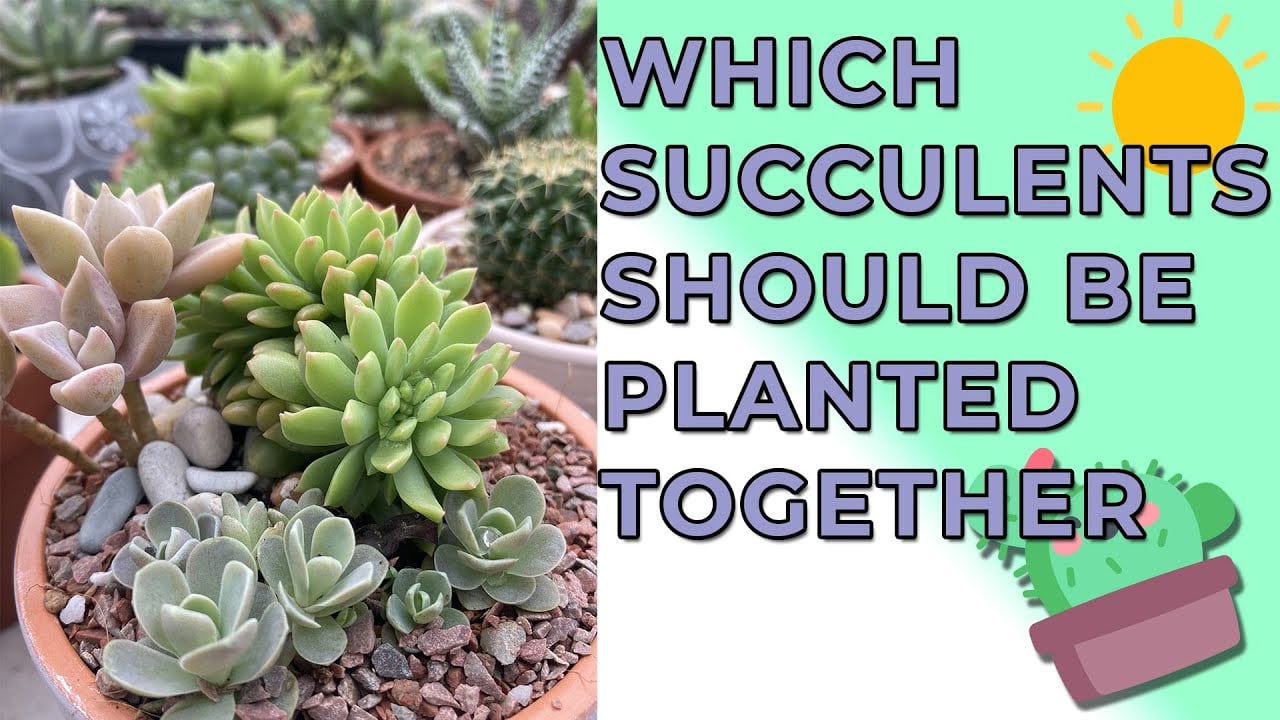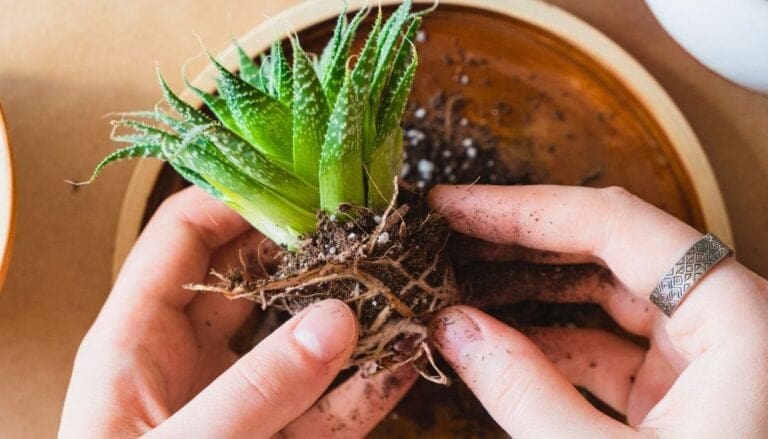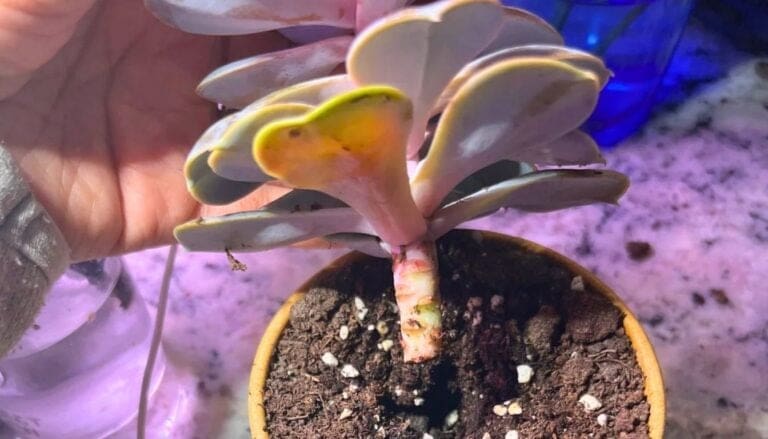Best Succulent Combinations: What Succulents Can Be Planted Together?
Who doesn’t love a good succulent garden? 🌵 They’re like living art pieces that bring life into any space.
Have you ever wondered which succulents pair best together?
Succulents like Echeveria, Sedum, and Aloe thrive when placed together. They not only look great, but they also have similar needs.
When I started my own succulent collection, I realized the importance of finding the right mix that shares sunlight and watering preferences.
Mixing tiny Crassulas with taller Haworthias can add depth to your arrangement. They create a vibrant landscape of green, purple, and silver shades.
Ever found yourself lost in choice at the garden center? Trust me, I’ve been there.
Keep reading to explore these combinations and turn your succulent game into something amazing.
What’s your favorite succulent combo? Let me know below! 🌿🎉
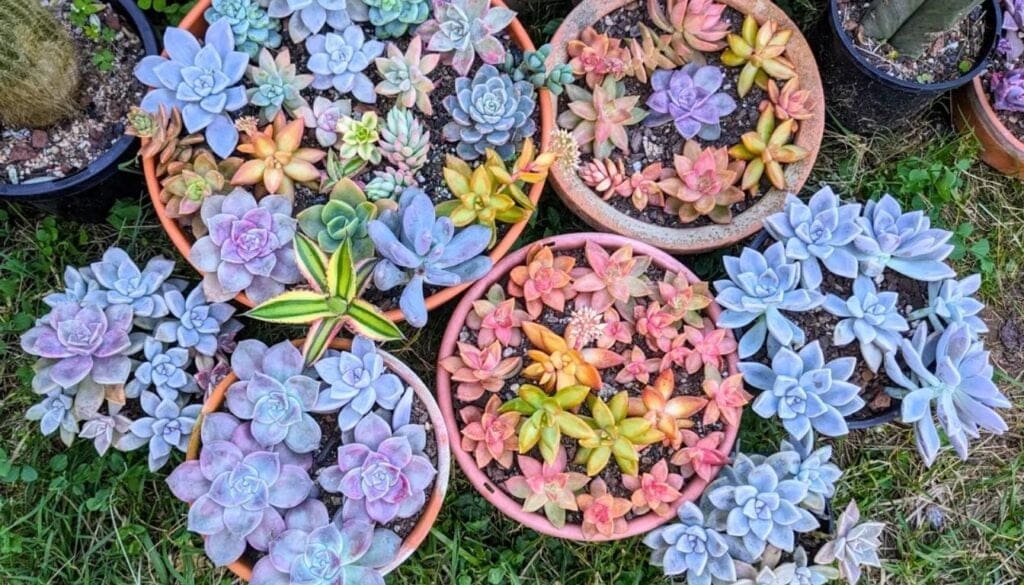
Please note: Simplify Plants is reader-supported. As an Amazon Associate, I earn from qualifying purchases made by our readers with no extra cost added to you all! Some links in the post are affiliate links and I get a commission from purchases made through links in the post.
Understanding Succulent Traits
I’ve always found succulents fascinating!
Whether it’s their watering habits, love for sunlight, or quirky soil preferences, each trait ensures these plants thrive.
Let’s look at why these factors make them such a joy to grow.
Watering Needs
Succulents are desert champions when it comes to water. They store water in their thick leaves, which means they don’t need to be watered as often as other plants.
I usually let the soil dry out completely before giving them a good soak.
Overwatering is their kryptonite—it can lead to root rot, so I’m careful not to drown them.
Are you surprised by how little they drink? 😄
Light Requirements
These little plants love the sun. You’ll often find my succulents basking in bright, indirect light.
Most need about 6 hours of sunlight daily, which keeps them happy and colorful.
If they start stretching and looking a bit leggy, it’s their way of saying, “Hey, I need more light!” 🌞
If natural light is limited, try using a grow light.
Soil Preferences
Succulents aren’t picky eaters, but they do have a favorite dish: well-draining soil.
Regular potting soil holds too much moisture for them.
I prefer using a cactus or succulent mix, sometimes adding perlite or coarse sand for extra drainage.
It’s like giving them a comfy bed where they can rest and grow without getting soggy. 🪴
Designing Your Succulent Arrangement

In creating a succulent arrangement, it’s crucial to focus on color, texture, and spacing. These elements can transform any pot into a stunning display. So, let’s dig in, shall we?
Color Coordination
I always start with color because it’s the first thing we notice.
Pairing succulents with contrasting colors can make your arrangement pop. For instance, a deep green jade plant next to a bright red Echeveria makes a bold statement.
Try a color wheel if you need inspiration. This tool can help me pick complementary or even monochrome greens for a peaceful vibe.
Mixing in splashes of purple, orange, or blue can also add life to your pot.
Think about the mood you want to create. A warm-color scheme feels cozy, while cooler colors are refreshing. What’s your favorite combo? 😃
Texture Variation
Each succulent offers a unique texture, from the smooth Haworthia to the spiky Aloe Vera.
For me, combining different textures is like mixing up puzzle pieces that fit perfectly.
I love using succulents with small, rosette-like leaves next to taller, spikier plants. This adds depth and makes the arrangement look dynamic.
Creating layers of texture keeps things interesting and ensures each plant has its own spotlight. Feel those textures! It’s like a tiny world of its own.
Sizing and Spacing
Now, let’s talk size.
Start by choosing a focal point with a larger succulent, like a cactus or Agave. Then surround it with smaller plants for balance.
Spacing is key. I leave enough room for growth, avoiding crowded conditions.
Over time, these plants will fill out. This gives the arrangement a rich and full feel, and ensures everything gets enough sunlight and air. 🌵
Do you want your arrangement to look full or allow room for growth? Remember, plants need space to thrive. 😄
I’d love to hear your design ideas! Feel free to share your favorite combos and arrangements below. Let’s turn our pots into creative masterpieces! 🌟
Popular Succulent Pairings
I’ve always been fascinated by how different succulents can thrive together. You can create stunning arrangements by mixing Sedum with Sempervivum, Echeveria with Crassula, and Aloe with Haworthia. These combinations not only look great but also share similar care needs. Let’s dive into the details, shall we? 🌵✨
Sedum and Sempervivum
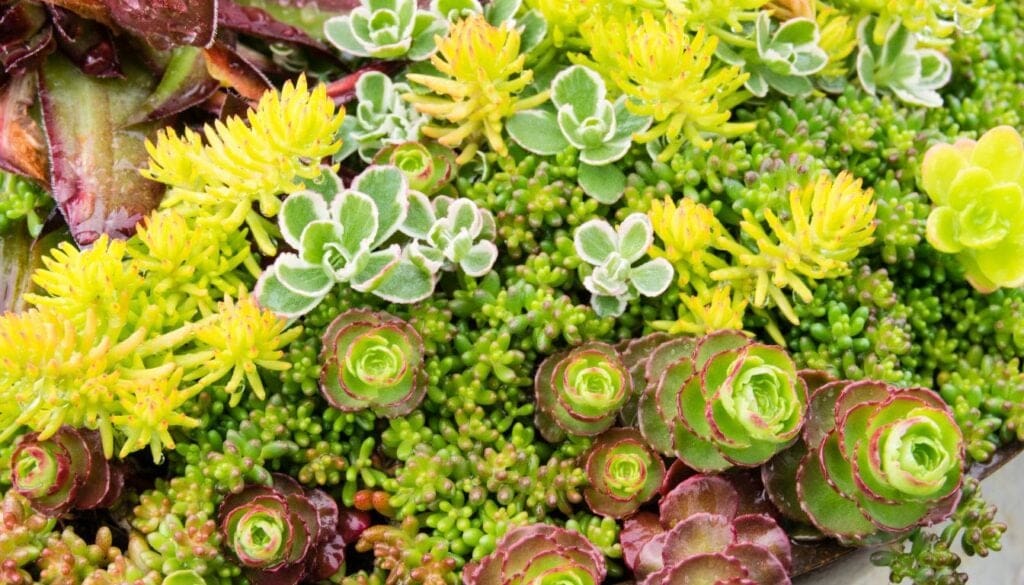
Sedum and Sempervivum make a perfect pair because both are hardy and low-maintenance.
Sedum, often called stonecrop, thrives with its thick, fleshy leaves storing water. Meanwhile, Sempervivum, also known as hens and chicks, grows in tight rosettes with its younger plants sprouting around the main one.
They both love full sun and well-drained soil, making them awesome for outdoor gardens or bright indoor spots.
You might find them—fun fact—rocking in rock gardens! The contrasting textures and colors can create eye-catching displays for any succulent lover.
Echeveria and Crassula

Now, when I mix Echeveria with Crassula, it’s all about the variety in shape and color.
Echeveria’s rosettes come in shades from blue-green to hints of red. Crassula, including the well-loved Jade Plant, adds fleshy, round leaves that complement this beauty.
Both these plants are sun-lovers, preferring bright, indirect light to bring out the best colors. I water them when the soil dries out, allowing their roots to breathe.
It’s amazing how diverse these two species can look together, bringing some serious life to any windowsill or desk!
Aloe and Haworthia

And then, there’s the combo of Aloe and Haworthia.
Aloe’s thick, often spotted leaves can handle the spotlight while Haworthia’s spiky charm often remains compact in size.
They don’t just look unique side by side; they also boast similar needs, thriving in bright, indirect light.
I let them dry out between waterings, which keeps them happy.
Here’s a tip: Aloe can sometimes flower, revealing tubular blooms! This duo is perfect for adding a touch of the exotic without fuss, making them ideal for busy plant enthusiasts.
What do you think? Got a favorite pair or a fun succulent story? Comment below and share! 👇🌿
Caring for Your Succulent Combination
Keeping succulents thriving can be fun and easy if you know the basics. 🌵 These include proper watering, feeding, and a little pruning and care.
Watering Techniques
I always remind myself, less is more when it comes to watering succulents! They love it dry, so I make sure their soil dries out completely between waterings.
I water every two weeks during the growing season, usually in spring and summer, and even less in winter.
I avoid watering the leaves since this can lead to rot. Instead, I focus on the base of the plant.
I love using a watering can with a narrow spout to be precise.
Keeping a watering schedule handy prevents me from overdoing it.
Who doesn’t use a calendar app these days? 📅 It helps to set reminders so you don’t forget and accidentally flood your lovely succulents!
Fertilizing Schedule

Succulents don’t need a lot of fertilizer, which is such a relief!
I usually fertilize them lightly during their active growing season with a diluted liquid fertilizer mix. Imagine giving them a gentle vitamin boost. 💪
I’ve found that twice a month is plenty. I steer clear of winter fertilizing since the plants aren’t actively growing.
It’s like feeding them when they’re not hungry—pointless!
Ever have those weeks where you barely want any work? Well, it’s the same for succulents in winter. They’ve worked hard enough growing, now let them rest and recharge without extra feed.
Pruning and Maintenance
Just like a good haircut, succulents do well with a little trim.
I pinch off dead leaves—these can block the light or collect moisture. I use clean scissors for larger cuts to keep everything neat.
Pruning helps succulents look fresh and prevents any bugs or diseases from taking hold. Plus, a tidy plant breathes easier, right? 🌿
I also rotate the pots so all sides get even sunlight.
It’s like turning over in bed to let both sides soak up the sun!
Remember, it’s all about balance and routine.
Don’t you want your succulents to look their best at every angle? So, keep them turning and prune away the mess for a happier plant!
Got your own succulent tips or funny mishaps you’d like to share? Drop them in the comments below! 😊 Your experience might just make someone’s day.
Troubleshooting Common Issues
When grouping succulents together, it’s important to tackle some typical challenges. From watering woes to pesky pests, I’ve got you covered with actionable steps to keep your plants happy and thriving. 🌵✨
Overwatering Signs and Solutions

Overwatering is a common mistake but don’t worry, there are clear signs to watch for.
Leaves might become mushy or drop off. Feeling the soil moisture with your finger can help too. Is it wet after several days? That’s a red flag!
Solution: Let the soil dry completely before watering again.
I always lift the pot to check its weight. Heavy? It’s still wet.
Want a simple tip to remember? Water sparingly! 🌧️
Try using pots with drainage holes. You’ll avoid those soggy plant blues.
Got tips for watering? Share them below! 💧
Pest Infestation Prevention
Oh no, pests! They’re tiny but mighty annoying.
Look for small webs or discolored spots. Ever found a surprise army of ants marching in your plant? They might be after an infestation of aphids.
Prevention: Keep leaves clean using a damp cloth. I like using a gentle spray made of water and dish soap.
Natural predators like ladybugs might also help.
Get creative in fighting those creepy-crawlies. Do these tricks work for you? Let’s chat in the comments! 🐞
Sunburn and Shading Measures
Sunburn in succulents is for real! Leaves may turn an unpleasant crispy brown.
Ever left your plant under full sun, thinking it loves it?
Succulents need some sunshine but they also crave shade.
Measures:
Gradually introduce them to brighter sun or find a spot with indirect light.
I love using sheer curtains to balance the light.
Not sure if it’s sunburn? Check for scorched leaf tips. Can you relate?
If so, how do you protect your succulents from sunburn? Let’s hear your best tips! ☀️
Remember, experimenting and observing which methods suit your plants can make a huge difference.
Let’s learn from each other and keep these lovely plants thriving! 🌿💬
Seasonal Care for Succulent Combinations
Taking care of succulents changes with the seasons. Learn how to protect them from winter’s chill, keep them thriving in hot summers, and handle transitions in spring and fall.
Each season has its own little challenges and needs, so let’s get into it! 🌵✨
Winter Protection
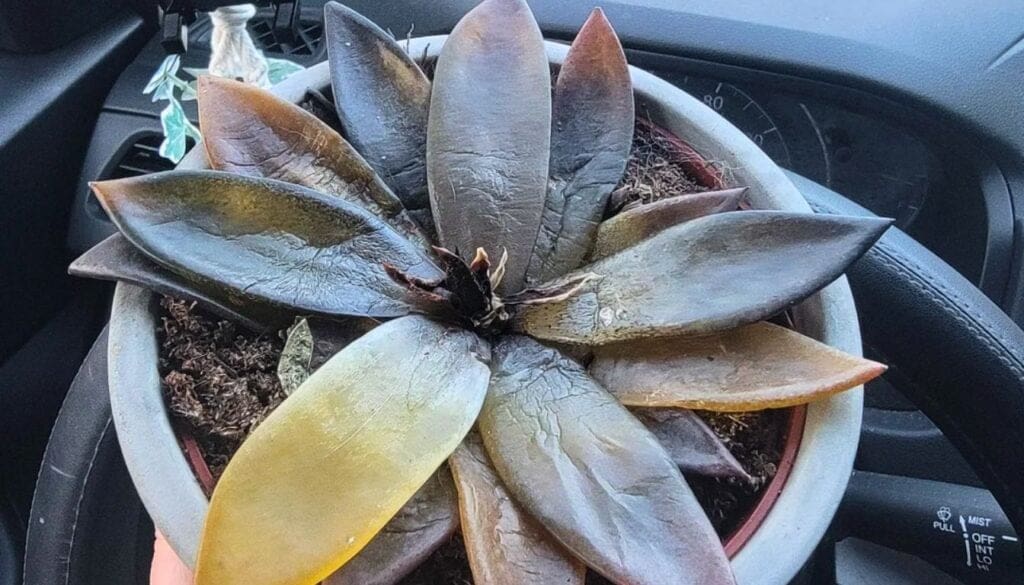
Winter can be tough on succulents, especially if they’re not used to cold.
I always move mine inside as soon as temperatures drop below 40°F (4°C).
If you can’t bring them indoors, a frost cloth can help keep them warm. It acts like a cozy blanket.
Also, switching to a south-facing window can give them more light.
Remember, these plants need less water in winter.
It’s tempting to water them on the same schedule, but succulents are quite fine with a little drought.
Too much water can lead to root rot. 😬
And hey, try not to set them near radiators; they can get too hot and dry out quickly.
Curious about winter care? Ever tried a different method that worked wonders? Drop your tips below.
Summer Care Tips
Summer is when succulents really shine, but direct sun can scorch them, especially the light-colored types.
I like to give mine a little shade in the afternoon. A sheer curtain or a shady spot works wonders!
Do you water your succulents more in the summer? I sure do! ☀️
With more sunlight, they dry out quickly, so I water them once the soil feels dry.
Remember, always water at the base, not on the leaves. Wet leaves in the hot sun can lead to sunburn. Ouch!
Keep an eye out for pests too. These little creeps love the summer as much as we do.
Got any pest-busting tricks? Share them with us!
Adapting to Spring and Fall Changes

In spring, succulents wake up from their winter rest and start growing again.
It’s the perfect time to repot or propagate new plants. I love trying out new combinations! 🌼
When it comes to nutrients, a light fertilizer can give them a boost.
During fall, succulents prepare for dormancy.
I find it helps to gradually reduce watering.
Less sunshine means slower growth and less thirst.
Keep an eye on overnight temperatures as they start to drop. It might be time to move them indoors!
Do you have a favorite spring or fall routine with your succulents? Share your experiences below.
Got questions or tips? I’m all ears! Let’s chat below. 🌿
Would love to know how you take care of your beautiful green friends.
Don’t forget to share this with your succulent-loving buddies! 😊
Propagation Strategies for Your Arrangement
Thinking of growing more succulents on your own? I’ve got you covered!
Let’s look at how you can propagate them using different methods: leaf propagation, stem cuttings, and offsets or pups.
These strategies will help you fill up those pots in no time. Who isn’t excited about more succulents? 🌵
Leaf Propagation

Have you ever tried growing a new plant from just a single leaf?
Leaf propagation is just that simple.
Pick a healthy, plump leaf. Gently twist it off the stem. Be careful not to break it, or it might not grow.
Let the leaf dry out for a couple of days until it forms a callus. This helps prevent it from absorbing too much water.
Afterward, place it on top of the soil. Too much watering is a no-go; spritz with a bit of water now and then.
Patience is key here, but in a few weeks, little roots and new leaves should sprout.
Keep it up, and soon, you’ll have a brand-new succulent buddy. 🌱
Stem Cuttings
This method’s a bit like giving your plant a haircut!
Trim a part of the stem, snipping it just below a leaf node. Let the cut end dry for a couple of days so that it won’t rot when planted.
Once dry, pop the cutting into the soil. Make sure it stands up straight.
Like a new haircut, it needs minimal fuss—a bit of water but not too much.
Check regularly to see how it’s rooting. This method works wonders if you want a fuller arrangement.
Do you think your succulents need a new look?
Offsets and Pups

Ever notice those tiny baby plants clustered around the base of your succulents? They’re called offsets or pups.
These mini plants are ready to leave their mama! 😄 Just twist them off gently.
Set them aside for some days to dry the ends.
Once ready, plant them into their new home.
These little ones settle in quickly, so you’ll see growth faster than with leaf or stem methods!
Feeling like a proud plant parent yet? Share your experience down below!
I’d love to know how your new arrangements turn out. 🌿
Potting and Repotting Your Succulents
Have you ever wondered the best way to pot your succulents?
First, make sure to use a pot with drainage holes. It helps prevent root rot from overwatering.
I always say: “A happy plant is a dry plant!” 😊
When it comes to potting mix, I choose one that’s well-draining and specially made for succulents. You can even make your own mix!
Use 2 parts sand, 2 parts garden soil, and 1 part perlite. It works wonders!
Repotting is similar.
How do you know when it’s time to repot?
Check if the roots are peeking out of the drainage hole or if the plant seems cramped. If yes, it’s time to find a bigger pot!
Make sure you remove any old soil from the roots. I find it helps the plant adjust more easily.
Tools I Love:
- Trowel: So handy for digging!
- Gloves: Keep those hands clean!
- Brush: For gently removing soil from roots.
Do any of you have a favorite tool? Or a funny repotting story to share? 😂 Drop it in the comments below!
I often get asked, “How often should I repot succulents?”
As a rule of thumb, every 1-2 years is good for most types. If you’ve got a slower grower, you can stretch it a bit longer. 🌵
Let’s chat in the comments!
Inspirational Succulent Combo Ideas
Have you ever wondered how exciting a pot of bright succulents could be? 🌵
Let’s mix and match some of my favorite combos to create a stunning display!
Want a lively scene? Use Echeveria, Aloe Vera, and Jade Plant together.
These little guys love sunlight and it’s like a mini desert party! Just make sure their pot has a good drainage hole so they can dance all day without drowning.
Imagine the calming vibes of blue and green hues. Combine Blue Chalksticks with Sedum and Agave.
The blend of textures is like nature’s artwork! Who doesn’t love a pot that paints itself? 🎨
Need some spark? Try the Firestick Plant with Rocks Cress.
It’s like setting your garden on fire without all the heat. 🔥
Why go wild with pastels? Pachyphytum and Graptopetalum create a soft garden full of charm.
It’s like having a pastel rainbow hanging out on your window sill!
Does anyone else love trying out new mixtures in their garden? Share your own combos and ideas in the comments!
Let’s get those creative juices flowing! 😊
Frequently Asked Questions
Planting succulents together requires some thought to ensure they thrive. It’s important to match their watering needs, avoid species conflicts, and pick the right soil.
What are some ideal pairings for creating succulent arrangements?
Combining Echeveria with Jade Plant makes for a lovely display. They both have similar light and water needs.
Aloe and Haworthia are another charming match. Both thrive in bright spots and have eye-catching leaves.
How do you choose succulents that complement each other’s watering needs?
Keep it simple! Look for succulents like Sedum and Sempervivum, which need minimal water.
Ask, “Do they live in the same conditions?” Matching their climate preferences ensures they’re happy together. 😊
Are there any succulent species that should not be planted in close proximity?
Watch out for aggressive growers!
Aloe can dominate slower-growing succulents, crowding them out.
It’s better to give Aeonium and Cactus a little space away from the crowd to avoid conflict.
Can you suggest some succulent combinations that thrive indoors?
Snake Plant and Burro’s Tail are buddies who love the shade.
Even a Zebra Plant welcomes a cozy, indoor setting. They don’t mind less light, making them perfect for desks or living rooms. Plus, they look stunning together! 🌵🌿
What type of soil mix is best for potted succulent arrangements?
Use a soil mix that drains well, like a cactus blend.
Good drainage is key! You can even add some sand or perlite to improve airflow. A healthy mix keeps those roots from turning soggy.
How do seasonal dormancy periods affect succulent pairing choices?
Some succulents nap in winter, while others snooze in summer!
Try pairing those that rest at the same time, like Agave and Portulacaria.
This way, you can water less during dormancy and keep them comfy all year. 🌞 💤
Got your own favorite combos? Share them in the comments!
Recommended Garden Supplies
| Product Image | Our Recommended Gardening Supplies | Check Offers! |
|---|---|---|
Top Top
Top
Top
Top
Top
Top
Top
Top | rePotme Houseplant and Tropical Classic Potting Soil Mix | Check Offer On Amazon |
 Top
Top
Top
Top
Top
Top
Top
Top | Espoma Organic Indoor Plant Food | Check Offer On Amazon |
 Top
Top
Top
Top
Top
Top
Top
Top | GooingTop LED Grow Light 6000K Full Spectrum Clip Plant Growing Lamp | Check Offer On Amazon |
 Top
Top
Top
Top
Top
Top
Top
Top | Soil Moisture Meter | Check Offer On Amazon |
 Top
Top
Top
Top
Top
Top
Top
Top | Govee Hygrometer Thermometer, Bluetooth Enabled! | Check Offer On Amazon |
 Top
Top | LEVOIT Humidifiers for Large Room(Best For Plants) | Check Offer On Amazon |
 Top
Top
Top
Top
Top
Top
Top
Top | Upgraded DIY Automatic Drip Irrigation Kit, 15 Potted Houseplants Support | Check Offer On Amazon |
 Top
Top
Top
Top
Top
Top
Top
Top | Stainless Steel Heavy Duty Gardening Tool Set | Check Offer On Amazon |
 Top
Top
Top
Top
Top
Top
Top
Top | Bonide Insecticidal Soap | Check Offer On Amazon |
 Top
Top
Top
Top
Top
Top
Top
Top | Bonide 32 oz Spray Neem Oil for Organic Gardening | Check Offer On Amazon |
 Top
Top
Top
Top
Top
Top
Top
Top | Garden Safe Fungicide | Check Offer On Amazon |

